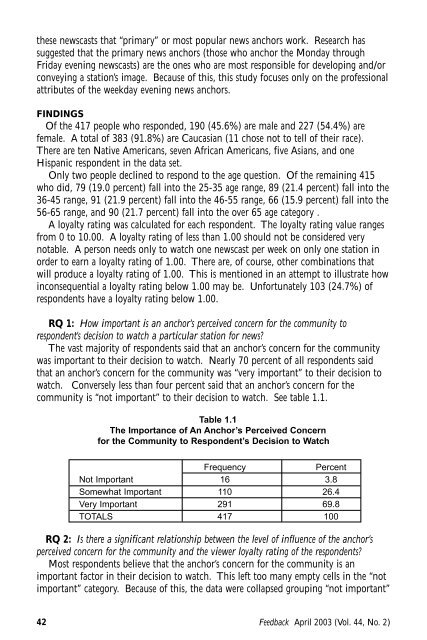APRILFeedback
Feedback April 2003 (Vol. 44, No. 2) - Broadcast Education ...
Feedback April 2003 (Vol. 44, No. 2) - Broadcast Education ...
- No tags were found...
Create successful ePaper yourself
Turn your PDF publications into a flip-book with our unique Google optimized e-Paper software.
these newscasts that “primary” or most popular news anchors work. Research hassuggested that the primary news anchors (those who anchor the Monday throughFriday evening newscasts) are the ones who are most responsible for developing and/orconveying a station’s image. Because of this, this study focuses only on the professionalattributes of the weekday evening news anchors.FINDINGSOf the 417 people who responded, 190 (45.6%) are male and 227 (54.4%) arefemale. A total of 383 (91.8%) are Caucasian (11 chose not to tell of their race).There are ten Native Americans, seven African Americans, five Asians, and oneHispanic respondent in the data set.Only two people declined to respond to the age question. Of the remaining 415who did, 79 (19.0 percent) fall into the 25-35 age range, 89 (21.4 percent) fall into the36-45 range, 91 (21.9 percent) fall into the 46-55 range, 66 (15.9 percent) fall into the56-65 range, and 90 (21.7 percent) fall into the over 65 age category .A loyalty rating was calculated for each respondent. The loyalty rating value rangesfrom 0 to 10.00. A loyalty rating of less than 1.00 should not be considered verynotable. A person needs only to watch one newscast per week on only one station inorder to earn a loyalty rating of 1.00. There are, of course, other combinations thatwill produce a loyalty rating of 1.00. This is mentioned in an attempt to illustrate howinconsequential a loyalty rating below 1.00 may be. Unfortunately 103 (24.7%) ofrespondents have a loyalty rating below 1.00.RQ 1: How important is an anchor’s perceived concern for the community torespondent’s decision to watch a particular station for news?The vast majority of respondents said that an anchor’s concern for the communitywas important to their decision to watch. Nearly 70 percent of all respondents saidthat an anchor’s concern for the community was “very important” to their decision towatch. Conversely less than four percent said that an anchor’s concern for thecommunity is “not important” to their decision to watch. See table 1.1.Table 1.1The Importance of An Anchor’s Perceived Concernfor the Community to Respondent’s Decision to WatchFrequencyPercentNot Important 16 3.8Somewhat Important 110 26.4Very Important 291 69.8TOTALS 417 100RQ 2: Is there a significant relationship between the level of influence of the anchor’sperceived concern for the community and the viewer loyalty rating of the respondents?Most respondents believe that the anchor’s concern for the community is animportant factor in their decision to watch. This left too many empty cells in the “notimportant” category. Because of this, the data were collapsed grouping “not important”42Feedback April 2003 (Vol. 44, No. 2)
















